Standard [CURRENT]
ASTM F 2752:2019
Standard Guide for Training for Basic Rope Rescuer Endorsement
- Publication date
- 2019
- Original language
- English
- Pages
- 4
- Publication date
- 2019
- Original language
- English
- Pages
- 4
Product information on this site:
Quick delivery via download or delivery service
Buy securely with a credit card or pay upon receipt of invoice
All transactions are encrypted
Short description
1.1 This guide, in conjunction with, and as an add-on to, Guide F2751 (or equivalent for other environments) defines the basic training required for a person who participates in rope rescue as part of a larger rescue duty. 1.1.1 Specifically, this guide defines the knowledge, skills, and abilities required for a person to assist with, and support, (under qualified supervision) basic rope rescue operations, including patient packaging, litter rigging, and basic rigging, in conjunction with other rescue duties. 1.1.2 This guide establishes the minimum training standard for an endorsed Basic Rope Rescuer as related to general, field, and rope rescue-specific knowledge and skills. 1.1.3 A Basic Rope Rescuer must work under the direct supervision of qualified rope rescue personnel. 1.2 An Endorsed Basic Rope Rescuer endorsement applies only to rescues on the surface of the land; additional endorsements are required to perform this level of rope rescue in other environments. This guide alone does not define the minimum training requirements for rescuing in partially or fully collapsed structures, in or on water, in confined spaces, or underground (such as in caves, mines, and tunnels). 1.3 A Basic Rope Rescuer is required to have knowledge and skill sets pertaining to the basic roped evacuation and carryout components of rescue. Only basic knots, rigging, and other patient transport skills are required of a Basic Rope Rescuer. 1.4 A Basic Rope Rescuer may be a member of a Rope Rescue Team or Rope Rescue Task Force or Group, as defined in Classification F1993 . 1.4.1 Further training may be required before a Basic Rope Rescuer may actually participate in a particular kind of rope rescue team, depending on the regulations or policies of the AHJ. 1.5 This standard does not purport to address all of the safety concerns, if any, associated with its use. It is the responsibility of the user of this standard to establish appropriate safety, health, and environmental practices and determine the applicability of regulatory limitations prior to use. 1.6 This international standard was developed in accordance with internationally recognized principles on standardization established in the Decision on Principles for the Development of International Standards, Guides and Recommendations issued by the World Trade Organization Technical Barriers to Trade (TBT) Committee.
Also available in
Loading recommended items...
Loading recommended items...
Loading recommended items...
Loading recommended items...

